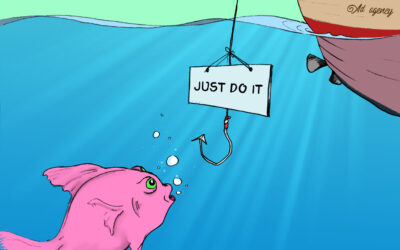How our brains work
Fortunately, they’ve evolved to help themselves. Faced with this onslaught of choices – some small, some large – our brains settle for quick and satisfactory rather than slow and optimal decisions.
These fast decisions take place in our Limbic brain – the evolutionarily older part – which works unconsciously and instinctively. It’s primarily emotional, and it can’t respond to language so relies on a rapid interpretation of the senses. This is known as System 1 thinking, and it accounts for up to 95% of our daily decisions.
Conversely, rational thinking and decision-making, known as System 2, take place in the Neocortex – the newer bit of the brain. It is reflective, cognitive calculating and harnesses language. But it’s a lot slower. Which is why it only accounts for 5% of our decisions. Who has the time?
Harnessing behavioural insights
The challenge for communicators and creatives is that most traditional marketing and design targets the rational, conscious, cognitive Type 2 brain; it relies too heavily on what people say they think, feel and act (their conscious responses), rather than how they think, feel and act. This focus on appealing to the Type 2 brain means that traditional design only targets as little as 5% of our decision-making.
The secret to working successfully with behavioural creative and scientific methods is to optimise the creative process and make it work seamlessly with how people make decisions.
Naturally, behavioural creative is still built on a powerful creative concept at its heart – that’s essential when you’re trying to build a deep emotional connection with your audiences. But it has a much greater focus on specific behaviours and uses more behaviourally-focused design techniques at all stages throughout the process.
Behavioural creative techniques
Here are the highlights of the seven behavioural creative techniques:
- Define the key behaviours: Identify them, be hyper-specific, and make them measurable.
- Prime your audience: Use the right mix of visual, cultural and emotional cues to drive pre-attention.
- Understand the context: How we feel, where we are, who we’re with, and what we’re doing will shape our choices.
- Grab attention with the nine stimuli: These capture attention immediately and instinctively by latching onto our deep-rooted, survival-based responses.
- Make processing easy: Brains are lazy, and have a bias towards information that is easier to process.
- Choose the right biases: There are 173+ biases and mental shortcuts that influence our decision-making. The trick is knowing which to target.
- Obsess over the details: Sweating the small stuff can be as important as the big-ticket items.
Prime your audience with design
One of the more interesting of the all the techniques is priming your audience by tapping into the associative networks in your brain. Priming is a phenomenon in which exposure to a stimulus, such as a word or an image, influences how one responds to a subsequent, related stimulus. It is thought to occur when particular mental representations or associations are activated before a person carries out an action or task.
Every day when you process the world around you, your brain is constantly making conceptual connections both consciously and unconsciously – these are your associative networks in action. Design fundamentally pulls together these visual, cultural, conceptual, contextual connections in a way that hopefully makes complete sense when presented to an audience. This is priming.
If it’s done well, the audience will instinctively understand the communication before their System 2 conscious brain starts to process the messaging.
The phrase ‘it just feels right’ is often heard when all elements of the communication are aligned. On a conceptual level, design and advertising is and has always been about making conceptual connections particularly at the core idea level.
With this understanding, it makes the ideas and design phases of the project even more interesting and potentially powerful. By integrating these and other behavioural science insights throughout how we write, design, test and iterate, behavioural creative ensures our creative work is always aligned to the realities of human decision-making and that delivers more impactful and effective results.












